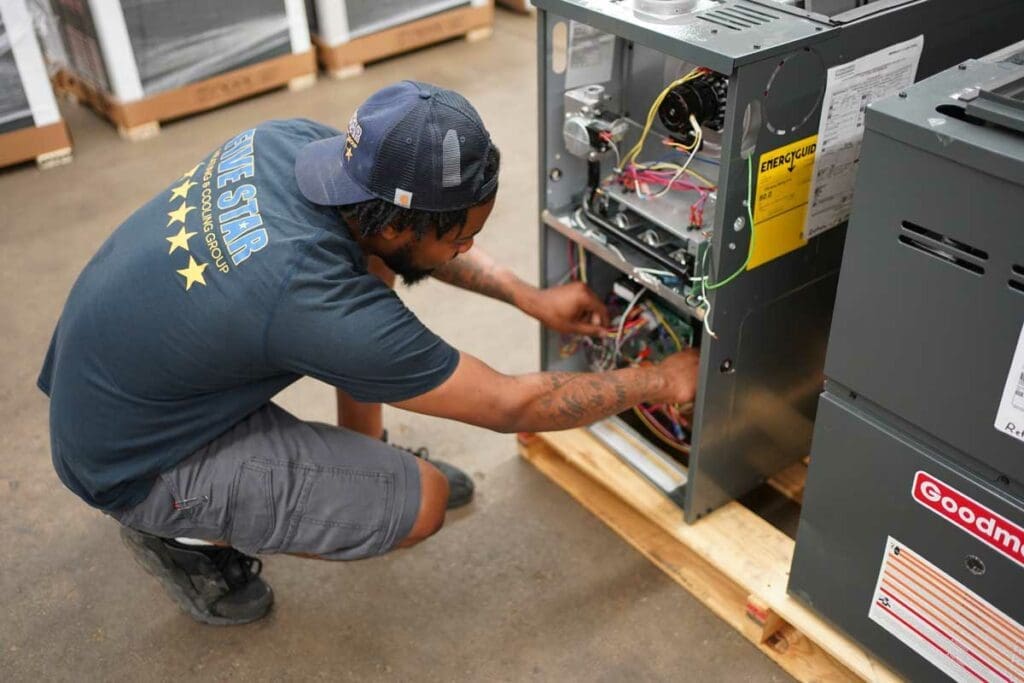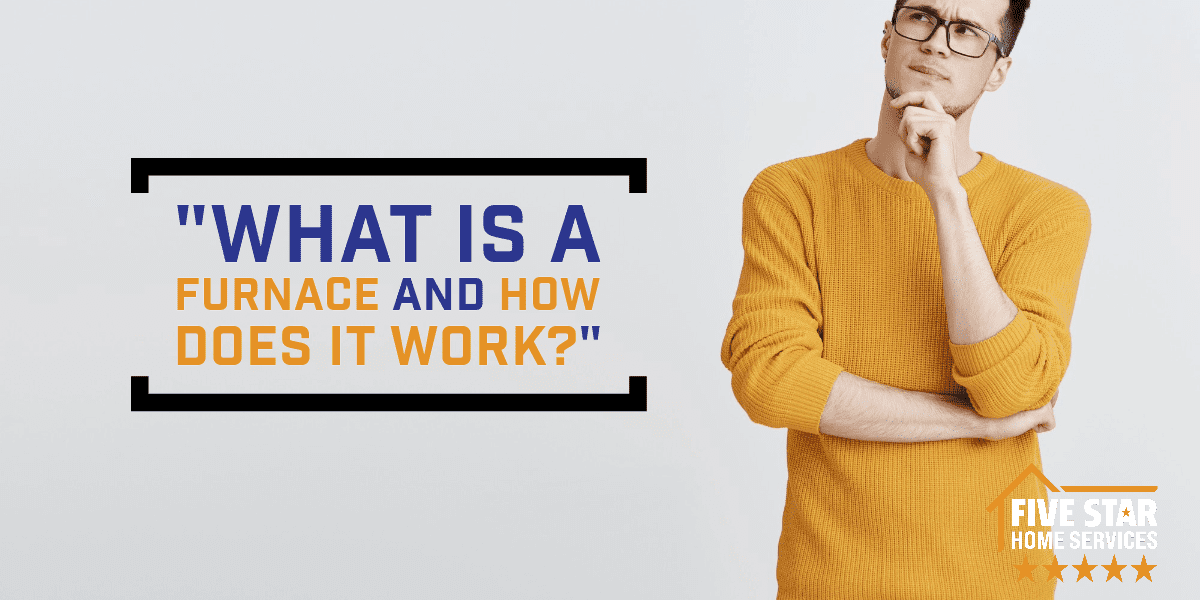Your Furnace 101 Resource Guide
Although the answer to this question might appear to be obvious and straightforward, there’s a lot more to furnaces than meets the eye. In the following, we will answer this question and cover the basics of how furnaces work — comparing the different types. From low-efficiency furnaces to high-efficiency furnaces, different blower types, and gas vs. electric furnaces, we will break down their various characteristics and mechanics.

During the wintertime, furnaces help homeowners ensure their family’s safety and comfort.
Ideally, they just do their job quietly and without any sort of fuss. If the only times you need to worry about your furnace are when it’s time for annual maintenance or when you’re getting ready for the winter months and want to ensure it’s performing at its full potential — consider yourself fortunate. There’s nothing better than a well-running heating system when it’s cold outside.
Nevertheless, maybe you’ve started to think about furnace replacement for your 15-year-old (or older) furnace. Perhaps you’re in the market for a unit that’s more efficient and more environmentally friendly. Perhaps you’re just tired of shivering in December due to a lack of truly warm air.
If you’ve been thinking about replacing your existing furnace, the following is a primer on home heating systems. We at Five Star Home Services want you to be as knowledgeable as possible when you sit down with a salesperson to discuss your options. After all, knowledge is power, and the more knowledge you have to make an informed buying decision, the better.
The more you know, the better your questions. The better your knowledge, the better your understanding of your options.
Below we begin with some of the basics:
Types of Furnaces
According to HVAC.com, furnaces can be classified into five general categories:
- Forced air
- Natural draft
- Induced draft
- Condensing
- Boilers
Forced-Air Furnaces
In older forced-air furnaces, heat is provided by cast-iron or sectional steel heat exchangers. The heated air is moved by blowers, which run at a variety of speeds. Energy efficiency would range anywhere from just over 50 percent to upward of 65 percent. Newer forced-air furnaces, nevertheless, are a lot more efficient.
Natural-Draft Furnaces
These furnaces are an older type of furnace. They are now considered to be energy hogs. Their estimated efficiency rating is somewhere between 65 percent and 70 percent AFUE — a rating that describes how much fuel your furnace uses to provide heat. Natural draft furnaces don’t have blowers. Nevertheless, many of them were later adapted to use electric blowers to facilitate air distribution. Natural draft furnaces also use pilot lights.
Induced-Draft Furnaces
Similar to a blower motor, a draft inducer in an induced-draft furnace is a motor that regulates and controls airflow, playing two essential roles:
- Draw in the air for combustion
- Remove the byproducts of combustion, such as carbon monoxide.
Condensing Furnaces
In most of these modern units, air is forced through the system with a blower. Condensing furnaces are also known as high-efficiency furnaces. They have a secondary heat exchanger that extrapolates heat.
The reason they are called condensing furnaces is because they pull more heat out through that secondary heat exchanger. The byproduct, which is carbon monoxide, is cooler. As the gas escapes, it begins condensing as it quickly cools. It then creates condensation, which goes out of the furnace as water to wherever the drain is.
Boilers
Although a bit more rare and outdated, boilers are still around. They are typically 40 to 50 years old. They distribute heat by heating water and pumping it through small pipes to heat baseboards, cast iron radiators, and radiant flooring systems. Some people I talk to love their boilers because they do generate nice heat.
To keep everything simple, however, the rest of this article will be spent talking about just condensing forced-air furnaces. The main components include burners, heat exchangers, and blower motors. Heat exchangers extrapolate heat. There is combustion from the burners — as it runs through that heat exchanger — it pulls out the heat. Then, the blower motor forces the air throughout the house via the air duct system.
Benefits of Condensing Furnaces
One of the biggest advantages of owning a condensing furnace rather than a standard forced-air furnace is the condensing furnace’s efficiency. Although lower-efficiency furnaces operate at around 80 percent. With higher-efficiency furnaces, you get more than 90 percent efficiency. In fact, most of them are 96 percent.
What Does 90 Percent Efficiency Mean?
The most obvious way to look at this question is to realize that for every dollar you spend to heat your home, you are getting 90 percent of it, and you are wasting 10 percent. This same conversion is true for an 80 percent efficient furnace: 80 to 20.
At 90 percent efficiency, you waste less energy and get more efficiency. If you have an 80 percent furnace with the addition of a secondary heat exchanger, it wastes more heat. Possible disadvantages of high-efficiency furnaces include the replacement process.
If you replace a standard-efficiency furnace with a high-efficiency one, and your existing system is located in the middle of your house, it will require evasive work in your home.
If the old vent goes up to the roof, you would have to tear up your basement’s drywall to make a path for the PVC pipe to run to the outside. High-efficiency furnaces need to be vented to an exterior wall and not up towards the roof.
Three Types of Fans
- Single-stage
- Two-stage
- Modulating
Single-stage furnaces have only one stage of operation. The heating system is either off or on — it’s always running at its highest speed and pumping air out at its highest velocity. One of its benefits is the overall cost of installation. Single-stage furnaces are relatively inexpensive. Their technology is simple. Nevertheless, the simplicity of single-stage gas furnaces comes at the cost of having a louder furnace blower motor. In addition to the noise, it has lower efficiency. Blower motors on these single-stage furnaces use a lot more energy overall — especially when compared to its counterparts: which are the modulating and two-stage furnaces.
Two-stage furnaces, as indicated by the name, have fans that can run at full speed and at reduced speeds. Two-stage furnaces run at 60 to 65 percent of the BTU (British Thermal Unit), which is a measure of heat. After that, it can go to 100 percent in the second stage. You basically have warm heat first and then hot heat. They are quieter and keep desired temperatures better inside the home. They also have longer operating cycles — providing more time for the air to distribute evenly and more time for changeover.
Modulating furnaces modulate the heating output as well as the air velocity almost continuously — depending on the demanded heat and the temperatures outside. This means that it works only as much as necessary and therefore saves you money on heating costs. Modulating gas valve furnaces run anywhere between 40 percent and 100 percent capacity. They provide the most comfortable heating throughout the home. It gives you the most consistent temperature spikes. Many homeowners want their homes to be 70 degrees throughout the year. These people are good candidates for a modulating system. Although they are the most expensive option, they are also the most efficient and save you money over the long run.
Do High-Efficiency Furnaces Save You Money?
Saving on heating is always a good thing. Unfortunately, when it comes to the amount saved, there’s no real black-and-white answer on whether it pays for itself. Take, for instance, homeowners with a gas furnace. Their gas bill might only come to around $70 per month. With a high-efficiency furnace, you save 16 cents on the dollar. At this rate, it’s going to take a long time to recoup the initial installation cost. However, if you know you’re going to be in the house long-term (say, for up to 10 years or more), and you’re in a bigger house with $150 monthly gas bills, that’s different. If you save 16 cents on the dollar — you’re going to start recouping that cost a lot faster. Over time, with higher gas bills, upgrades pay for themselves.
Another factor we should mention that many people consider is their carbon footprint. What responsible homeowner doesn’t want to have less of an effect on the environment? Upgrading makes you feel good knowing you did something responsible for Mother Nature!

When Would an 80 Percent Efficient Furnace Be Feasible?
The answer to this depends on several factors. Some people already have high-efficiency furnaces. If you have a high-efficiency furnace, it doesn’t help to go backward. It may not even be a possibility. However, if you have an older home with a high-efficiency furnace that was converted from a standard 80% to a high-efficiency furnace, that’s different. In this case, you could go back to 80% if you really wanted to. Nevertheless, most of the time, if you have a high-efficiency furnace, there’s no reason to go backward.
Air Handlers Vs. Furnaces
Furnaces are a great source of natural gas heating, and their air handler serves as more than a fan. Air handlers are blower motors with a coil for cooling. If you are using an all-electric system for your heat source, you would have an air handler with electric heat strips. Some people refer to it as emergency or back-up heat. Electric heat strips produce heat when the heat pump outside isn’t able to keep up due to the cold temperatures.
Gas Furnaces Vs. Electric Furnaces
Now we will explore the differences between heating systems powered by gas and heating systems powered by electricity. All-electric systems are air handlers. Some people refer to them as electric furnaces. They use an electric heat strip inside the unit. They are usually combined with heat pumps. In this setup, heat pumps are essentially air conditioners with reversing valves that generate heat.
However, heat pumps are only able to heat up to a certain point. Usually, it is about 40 degrees. If outdoor temperatures go too low, it can cause them to lose their heating efficiency. If this happens, the HVAC system will begin to rely on the backup heat strips to make up that difference in temperature.
In short, gas furnaces are much more efficient than electric furnaces. Electricity costs more than natural gas. However, some people just don’t have access to natural gas. Electric heating is their only option. Sometimes the gas company is able to run gas to a home and up to a certain distance for free. If the distance is too far, you have to pay for the remaining distance.
If you convert from gas to electric, your initial investment could be more. We may have to add a gas line. Sometimes duct modifications are necessary.
How Do We Determine the Recommended Size Furnace?
Your friends at Five Star Home Services determine the size of a replacement furnace by completing a load calculation. This is the only way to accurately determine the right-sized equipment going into the home. Load calculations include window size and factors in the direction of the windows. We also factor in the total number of doors. We measure the thickness of the walls, which gives us an idea of the amount of insulation. We look at the insulation in place inside your attic. Some homes are on a slab, some are over a crawl space, and others are over a basement. Your friends at Five Star Home Services check everything and take these factors into consideration. It matters because that is the correct way to determine the size of the system. If your system is too big or too small, it obviously affects your energy costs.
If the system is too big, it will probably short cycle. This is when the furnace fires on, the thermostat thinks that the temperature is satisfied, and then it turns off. After the air mixes a little bit more, it fires on again and stays on for a few minutes. Then, it’s off for a few minutes again. This is usually a tell-tale sign the furnace is oversized. It doesn’t have the proper amount of run time for the air to mix and provide the type of even temperature distribution. Eventually, this wears out the system prematurely.
If your system is undersized, on the other hand, it will never keep up with the outside temperature. It will likely run all of the time, putting on unnecessary wear and tear. It will wear out much sooner than if it were sized properly to begin with. You will be cold and uncomfortable on a regular basis.
Now That You Know, the Next Step Is to Give Us a Call!
Your friends at Five Star Home Services love keeping you — our amazing customer — as comfortable as possible. We also want to keep you informed, hence our resource library! If you have additional questions, don’t hesitate to give us a call! We are more than happy to meet with you in person to go over more specifics. We are always available 24/7.
Get started with a quote today!

